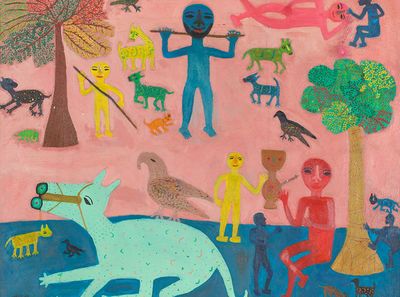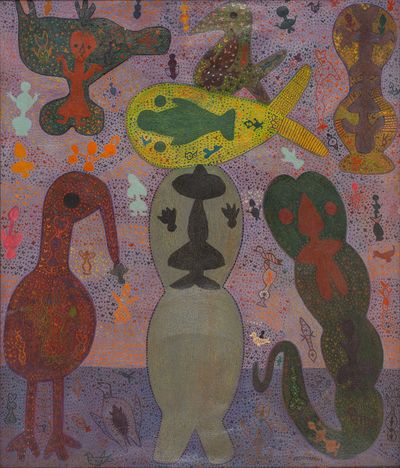Madhvi Parekh Defies Categorisation in New York Retrospective
According to Kishore Singh, the curator of The Curious Seeker at DAG New York (13 September–27 October 2019), the artist Madhvi Parekh 'defies categorisation'. Parekh's oeuvre—from drawings and paintings to serigraphs and reverse paintings—fluidly draws from multiple sources, including European modernist works, Indian folk art, religious iconography, and personal memories. These influences are on display in The Curious Seeker, which presents over 65 of the artist's rich narrative works, and follows previous presentations at DAG Modern's spaces in New Delhi (2017) and Mumbai (2018).

Madhvi Parekh, Playing With Animals (1989) (detail). Oil on canvas. 113.5 x 139.7 cm. Courtesy the artist.
Parekh's trajectory has been unorthodox from the start: she never intended to become an artist growing up in the small temple town of Sanjaya in Gujarat, India, instead aspiring to become a doctor. She was introduced to art in 1964 when her husband, an artist, gave her a copy of Paul Klee's Pedagogical Sketchbook (1925). Based on the Swiss-German artist's lectures at the Bauhaus, the book outlines a theory-based approach to art-making with exercises using fundamental geometric shapes. After a few days, Parekh grew tired of following the textbook and started making her own drawings. Four Drawings (1964), for example, features an array of triangles, circles, and rectangles—shapes that imply Klee's influence, while textures of dots and dashes recall Kantha or Sujani embroidery.
Among these early drawings in The Curious Seeker is Flying Figure (1974), a pen on paper work depicting a body composed of lines and dots. Variations in marks create a distinct sense of rhythm that foreshadows Parekh's pulsating and vivid paintings that followed, into which her experiences, especially of village life, flowed. Untitled (1968) is an oil on canvas depicting a gathering of human figures with dogs and chickens, rendered in bright colours and with small dots, crosses, and crescent-shaped marks filling out their bodies.
Hindu fables are frequently referenced throughout Parekh's vivid paintings. The oil on canvas Sea God (1971) depicts a three-legged figure with bulbous limbs, surrounded by mythical creatures floating in bodies of blue and green. The composition and colour palette recall Behrupiya, a traditional Indian art form in which performers paint their bodies and don costumes to play characters from fables. (Though now in decline, Behrupiya was popular when Parkeh was young, as she reminisced in an interview with The Hindu Business Line in 2018.)
Other works draw from textile art forms such as Kalamkari, known for representing the Hindu epic Ramayana, and Pichwhai, the devotional pictures depicting tales of Krishna. World of Kali (1971) is a full-body portrayal in oil and oil pastel of the four-armed goddess Kali; while the oil painting Kaliadaman (1993) retells the tale of Krishna taming the serpent Kaliya. Many Pichwai paintings feature frames—either decorative or narrative—a device that Parekh seems to employ in works such as Untitled (2005), which places the demon-slaying goddess Durga in the centre, framed by ladders and round-eyed human figures in black.
In recent years, Parekh's work has become increasingly influenced by her travels to Russia, West Asia, and Europe, where she visited churches and sites of war, contemplating what has been committed in the name of religion. Since 2006, she has created paintings featuring Christ, for which Parekh often employs vibrant colours and black outlines found in her other works of Hindu deities. The Last Supper (2011)—the artist's take on Leonardo da Vinci's 15th-century masterpiece—was made using the reverse painting technique on acrylic sheet: a style that, on glass, dates back to the Middle Ages in Europe, which Parekh apparently learned from fellow artist Nalini Malani.
While Parekh never received formal art education, the course of her paintings over the decades show affinities with the Bengal School of Art, an art movement that arose in 20th-century India seeking to revive traditional Indian painting conventions that had declined in popularity due to preference for British- or European-style art. With leading figures such as Abanindranath Tagore, Manishi Dey, and Sudhir Khastgir, works associated with the Bengal School of Art reflect influences of styles with Western origins but focus on themes from Indian history and culture.
Because of her recurring subjects that concern rural Indian life and Hindu narratives, however, Parekh has more often been associated with folk art, an association that The Curious Seeker seeks to overturn by highlighting the breadth of Parekh's work. What comes into view is an artist who has interwoven folk traditions with modern styles, whether Indian or European, in both subject and execution. —[O]









































































































































































